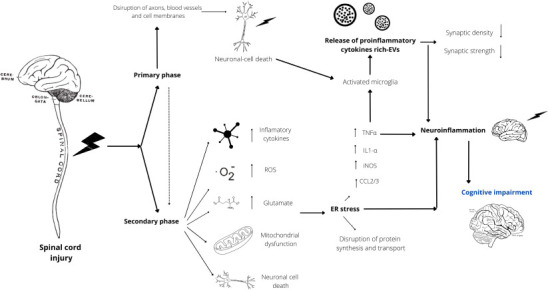Figure 1.

Diagram schematizing the pathophysiology of spinal cord injury (SCI)-mediated cognitive impairment.
After an aggression to the spinal cord, there is a primary response phase, characterized by alterations in the cellular microenvironment and neuronal death, followed by a late secondary response phase, where a series of events such as the release of proinflammatory cytokines, reactive oxygen species (ROS), glutamate excitotoxicity, mitochondrial dysfunction, and neuronal cell death aggravate the initial state of injury. This phase triggers a process known as “endoplasmic reticulum (ER) stress”, which is characterized by promoting an increase in several proinflammatory cytokines, resulting in the activation of local microglia and the release of extracellular vesicles (EVs) containing proinflammatory cytokines, which in turn travel through the bloodstream to critical areas of the brain. This event coupled with neuronal death and ER stress leads to a state of neuroinflammation that ultimately leads to the development of cognitive impairment. CCL2/3: Chemokine (C-C motif) ligand 2/3; ER: endoplasmic reticulum; EVs: extracellular vesicles; IL1-α: interleukin 1α; iNOS: inducible nitric oxide synthase; ROS: reactive oxygen species; TNFα: tumor necrosis factor α.
